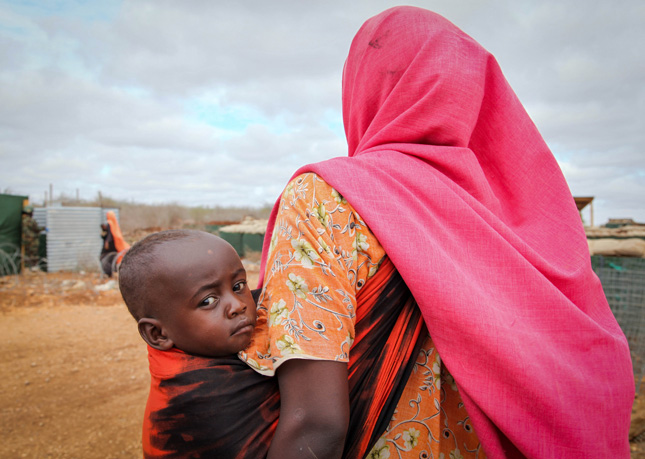-
No Mother Left Behind: How Conflict Exacerbates the Global Maternal Health Challenge
November 7, 2016 By Nancy Chong
Since the end of World War II, the number of wars between states has declined significantly, but the number of intrastate civil conflicts – as seen in Syria and Afghanistan – has increased.
In many conflict-stricken, fragile countries today, individuals live in a “gray zone”: neither fully at war nor fully at peace. This development has played a significant but hidden role in holding back efforts to improve maternal health and women’s status.
Every day, about 800 women die from preventable complications during pregnancy and childbirth—and more than half of those deaths take place in fragile states afflicted with armed conflict or high levels of violence. Recent findings by the World Health Organization indicate that 75 percent of the countries with the highest maternal mortality ratios (above 300 deaths per 100,000 live births) are fragile states affected by conflict at a level below open warfare.
From the destruction of health facilities to magnifying existing social inequalities, low-level armed conflict affects maternal fatality, utilization of maternal health services, and women’s participation in conflict prevention and resolution in many ways.
From Morbidity to Disenfranchisement
According to a 2015 study by Primus Che Chi, Patience Bulage, Henrik Urdal, and Johanne Sundby, the effects of low-level armed conflict on maternal mortality and morbidity have been substantial in Burundi and Uganda.
From 1993 to 2005, a civil war driven by ethnic conflict between Hutu and Tutsi groups in Burundi killed 300,000 people and displaced millions to neighboring countries like Tanzania and the Democratic Republic of Congo. In northern Uganda, an insurgency from 1986 to 2006 displaced 2 million people internally. Many of those forced from their homes in both civil wars lived in deplorable and overcrowded conditions, lacking access to sufficient food, clean water, and comprehensive health care.
In Burundi, in part because of the ethnic nature of the conflict, health providers were targeted for killing and favoritism was observed in the provision of services. An increase in obstetric fistula cases has been linked to the conflict because of the lack of health workers, facilities, and supplies to conduct safe births in the country.
The targeted killing of health care providers and attacks on infrastructure appears to be a growing tacticIn northern Uganda, where the conflict was one of insurgency, the rebels abducted health workers and displaced many. HIV/AIDS prevalence also rose from 7 percent to nearly 12 percent after the conflict, along with increased levels of intimate partner, sexual, and gender-based violence. Besides the decline in available health services, disease transmission was perpetuated by prostitution in displacement camps.
In both countries, health care facilities were destroyed, medical supplies and equipment were mismanaged, and mobility was constrained. Prostitution and undercover and unsafe abortions increased as young girls were left without families and support systems and widows were left with few other options. There were long-term consequences of conflict as well. Governments shifted their focus to invest less on infrastructure, setting maternal and reproductive health services back compared to neighboring areas without conflict. An ambulance driver working in northwestern Uganda reported last year that trips to the closest medical center can be 40 minutes long.
“The targeted killing of health care providers and attacks on health infrastructure during armed conflicts appears to be a growing and worrying tactic in modern day warfare,” write Che Chi et al. They point to similar studies that have revealed maternal health effects from violence in Mexico (ambulance services that would not operate at night), Bosnia-Herzegovina (35 percent of health facilities badly damaged or destroyed), and Colombia and Nepal (patients targeted for religious, political, or ethnic affiliation).
In settings stuck in the gray zone, the decline in access to and quality of maternal health care in turn makes it harder for women and girls to participate in the peace process, as more women and newborns face health complications. “Family planning can be a big factor in women’s participation,” Sarah Chynoweth of the Women’s Commission for Refugee Women and Children told UN Radio.
Such participation by women and girls is considered by many to be a critical element to the success and sustainability of peace. In an evaluation of peacebuilding programs in the Democratic Republic of Congo, Republic of Congo, Rwanda, and Uganda, the International Center for Research on Women found that the initiatives that prioritized including women were more likely to be successful than those that did not. The UN has also actively highlighted the role of women in managing and resolving conflicts. Yet over the past 20 years, only nine percent of peace negotiators have been women.
What Is Being Done
Short of preventing or ending conflict, some of the recommendations to counteract the prevailing effects of conflict on maternal health from Che Chi et al. are focusing on mobile health services to make up for lack of mobility for affected populations, negotiating ceasefires explicitly to provide medical services to affected populations, and using community structures (e.g., community health workers) to provide basic care.
It may be that providing better care is a part of producing more durable peaceInternationally, the United Nations Population Fund (UNFPA) has set a goal to reach 40 million people in crisis settings with sexual and reproductive health information and services by 2017, as well as gender-based violence prevention and response services. In order to do this, UNFPA launched the Safe Birth Even Here campaign. It looks holistically at providing a full range of health services to protect maternal health in crisis settings – including family planning, sexual health education, and gender-based violence prevention – and is backed by companies like Bayer, United Colors of Benetton, General Electric, and Johnson & Johnson. The International Planned Parenthood Federation has also agreed to provide 1.5 million life-saving services by 2022 for women and girls in conflict prevention and response initiatives.
UNFPA’s Minimum Initial Service Package, or MISP, serves as a blueprint for humanitarian actors, peacekeeping forces, and donors on the most critical actions required in a humanitarian crisis, including conflict. In response to the massive humanitarian crisis in Syria, the American University of Beirut recently announced they are adapting the MISP to make the guidelines more relevant to the Middle East and North Africa (i.e., the needs of refugees in informal, protracted, and urban settings).
Connecting the Narrative to Policy
There may also be an optics challenge. Julienne Lusenge, an activist in the Democratic Republic of Congo and president of Female Solidarity for Integrated Peace and Development, said during the 2016 Women Deliver conference that although women and girls may be perceived as victims of war, their stories and experiences are also keys to creating lasting peace – and they are often ignored.
Accounts of poor or non-existent access to health care, counseling women on pregnancies from rape, shortages of midwives, facing birth-related complications with no resources, and the destruction of health infrastructure are testaments to the many ways even low-level violence disrupts society. The missing step in too many places is connecting these narratives to the negotiators and policymakers writing the treaty or directing reconstruction aid – or changing the makeup of these decision-making bodies to better reflect women’s issues.
“It really puzzles me,” Rajat Khosla, a human rights advisor at the World Health Organization told delegates at the World Humanitarian Summit in Istanbul. “In spite of knowing the fact that sexual and gender-based violence rises exponentially during conflict, post-conflict situations, and in populations of displacement…one set of services that we do not want to provide to women and girls is access to reproductive health services, contraception, [and] safe abortion services.”
As the maternal health community takes stock after 15 years of the Millennium Development Goals, the effect of conflict cannot be ignored on aspirations for a “grand convergence” of health services between rich and poor countries. And it just may be that providing better care is a part of producing more durable peace.
Source: BBC, BMC International Health and Human Rights, The Huffington Post, International Center for Research on Women, International Planned Parenthood Federation, Inverse, Peace Research Institute Oslo, RAND, UNICEF, UN Radio, UN Women, United Nations Population Fund, Women Deliver, Women’s eNews, World Health Organization.
Photo Credit: Mother and child visit a clinic in central Somalia run by soldiers of the African Union Mission in Somalia, courtesy of Abdi Dakan/African Union. Video: Women Deliver.
Topics: Bosnia and Herzegovina, Burundi, Colombia, conflict, Dot-Mom, DRC, family planning, featured, GBV, gender, global health, health systems, humanitarian, maternal health, Mexico, Nepal, newborn and child health, SDGs, security, Uganda, UN, UNFPA, video, youth
 A Publication of the Stimson Center.
A Publication of the Stimson Center.







